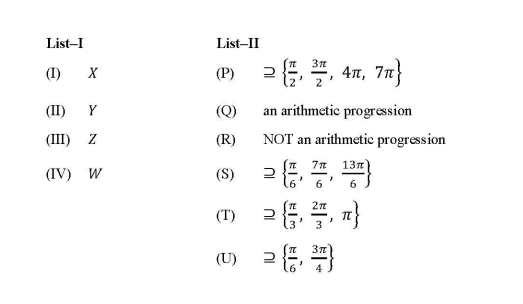If A={x:f(x)=0} and B={x:g(x)=0} then A∩B will beSolution in Tamil
[f(x)]2+[g(x)]2=0
f(x)g(x)
g(x)f(x)
None of these
The correct Answer is:A
Step by step video, text & image solution for If A={x:f(x)=0} and B={x:g(x)=0} then AcapB will be by Maths experts to help you in doubts & scoring excellent marks in Class 12 exams.
Topper's Solved these Questions
- BOOK - NEW JOYTHI PUBLICATIONCHAPTER - SETSEXERCISE - QUESTIONS FROM COMPETITIVE EXAMS21videos
SETS
- BOOK - NEW JOYTHI PUBLICATIONCHAPTER - SETSEXERCISE - QUESTIONS FROM COMPETITIVE EXAMS21videos
SETS
- BOOK - NEW JOYTHI PUBLICATIONCHAPTER - SEQUENCES AND SERIES EXERCISE - QUESTIONS FROM COMPETITIVE EXAMS105videos
SEQUENCES AND SERIES
- BOOK - NEW JOYTHI PUBLICATIONCHAPTER - STATISTICSEXERCISE - QUESTIONS FROM COMPETITIVE EXAMS40videos
STATISTICS
Similar Questions
If A and B are not disjoint sets then n(A∪B) is equal to
12:32View SolutionIf A and B are not disjoint sets then n(A∪B) is equal to
12:32View SolutionThe sum to n terms of the series 12+34+78+1516+....... is
03:11View SolutionThe mean mark in Statistics of 100 students in a class was 72 .The mean mark of boys was 75, while their number was 70. The mean mark of girls in the class was
06:51View SolutionAnswer the following by appropriately matching the lists based on the information given in the paragraph.
Let f(x)=sin(πcosx) and g(x)=cos(2πsinx) be two functions defined for x>0. Define the following sets whose elements are written in the increasing order:
X={x:f(x)=0},Y={x:f′(x)=0},Z={x:g(x)=0},W={x:g′(x)=0}
List-I contains the sets X,Y,Z and W. List-II contains such some information regarding these sets:
Which of the following is the only CORRECT combinations?View SolutionAnswer the following by appropriately matching the lists based on the information given in the paragraph.
Let f(x)=sin(πcosx) and g(x)=cos(2πsinx) be two functins defined for x>0. Define the following sets whose elements are written in the increasing order:
X={x:f(x)=0},Y={x:f′(x)=0},Z={x:g(x)=0},W={x:g′(x)=0}
List-I contains the sets X,Y,Z and W. List-II contains such some information regarding these sets:
Which of the following is the only CORRECT combinations?01:59View SolutionIf A={x:f(x)=0}andB={x:g(x)=0}, then A∪B will be the set of roots of the equation
04:00View Solutionयदि A={x:x2−5x+6=0,x∈N},B={1,3,5,7},C={2,4,5,6,8}, तो सिद्ध कीजिए कि :
A∪(B∩C)=(A∪B)∩(A∪C)04:51View Solutionयदि A={x∈IR:x2+6x−7<0} और
B={x∈IR:x2+9x+14>0} हो तो , निम्नलिखित में से कौन - सा / से नहीं है ?
(A∩B)=(−2,1) II. (A−B)=(−7,−2)02:32View SolutionIf ∣∣ ∣∣0x−ax−bx+a0x−cx+bx+c0∣∣ ∣∣=0 then the value of x is -
08:45View SolutionThe converse of "if x∈A∩B then x∈A and x∈B", is
06:26View SolutionThe contrapositive of "if x∈A∩B then x∈A and x∈B", is
03:18View SolutionA={x:x2+5x+6=0}, B={2,4} এবং C={4,5} হলে A×(B∩C) হবে -
08:09View SolutionLet A={x : x is a natural number}, B ={x : x is an even natural number}
C={x : x is an odd natural number and D={x : x is a prime number}
Find A∩B,A∩C,A∩D,B∩C,B∩DandC∩D.03:12View SolutionLet A={x : x is a natural number}, B ={x : x is an even natural number}
C={x : x is an odd natural number and D={x : x is a prime number}
Find A∩B,A∩C,A∩D,B∩C,B∩DandC∩D.07:23View SolutionLet A={x : x is a natural number}, B ={x : x is an even natural number}
C={x : x is an odd natural number and D={x : x is a prime number}
Find A∩B,A∩C,A∩D,B∩C,B∩DandC∩D.02:07View Solution



